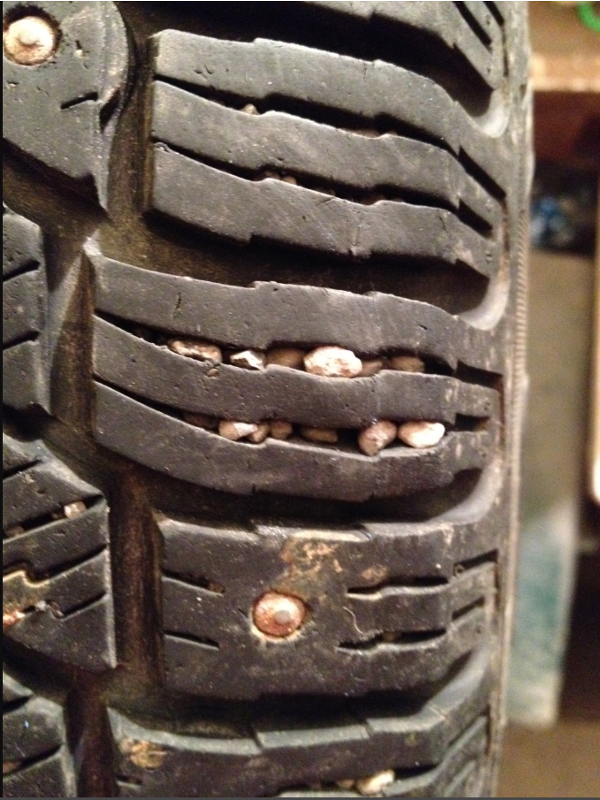Tires can become damaged for a variety of reasons, and it can happen without the driver being immediately aware there's a problem. The most common types of damage are punctures, cuts, impacts, cracks, bulges and irregular wear. In this section, we'll explain the signs and symptoms to help you diagnose the issue, plus some useful tips on how to prevent them.
There are several types of irregular wear, the most typical variations being heel and toe wear, one-sided wear, and center wear. Here we explain how and why they occur.
a. Heel and toe wear
Heel and toe wear is a pattern caused by normal usage and suspension settings. It's the outwardly visible (and audible) manifestation of various distortional forces at work on the tread. To explain further, let's dive a little deeper into the design of the tread.
Tread grooves and sipes are essential in ensuring safety on wet and flooded roads. Particularly with low-profile tires, a higher percentage of tread void is necessary to take up the water and to improve protection against aquaplaning. Cross-grooves for water drainage take the form of freestanding blocks in the shoulder area. These shoulder blocks can wear into a heel and toe pattern as a result of rolling mechanisms under certain operating conditions.
These operating conditions include:
While the tire is rolling along the road, the freestanding blocks deform as they approach the contact patch of the tire, and they're compressed as they touch the tarmac. After they lose road contact, however, the blocks will snap back into their original shape, rubbing the surface as they do so. The result is a wear pattern on the block run-out edge, and it's more likely to appear on non-driven wheel positions.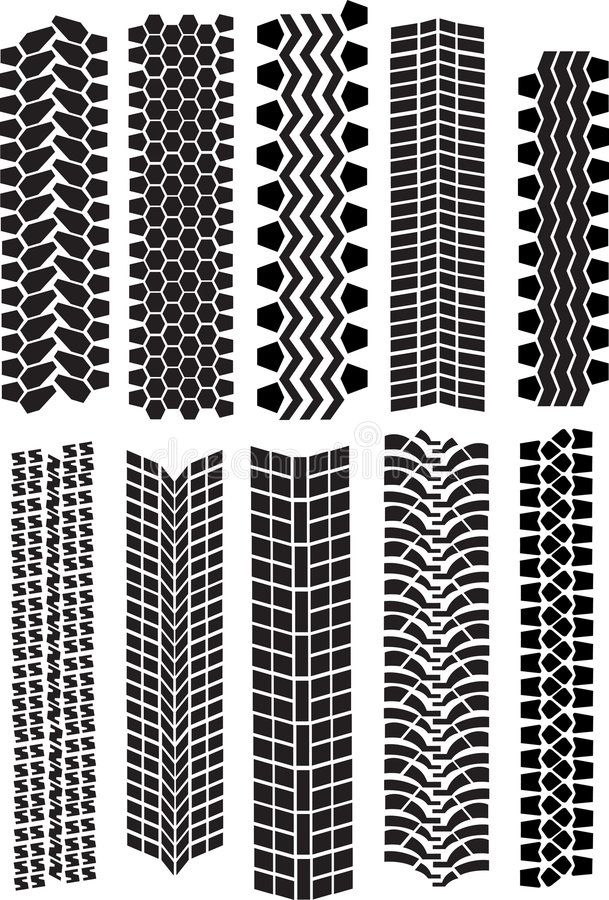
A minor amount of heel and toe pattern wear is reasonable and has no discernible effects on driving comfort. But if the wear is more extensive, more specific issues may be at fault. These can range from improper inflation, excessive toe-in, and low-wear applications.
b. Center wear
You can find this wear pattern on the driven wheels of highly motorized cars. During energetic acceleration, in stop-start urban traffic, or when accelerating away from traffic lights, these high torque levels can quickly increase wear of the tread center. Even today’s mid-range vehicles have modern engines which can generate high levels of torque and are capable of producing high degrees of slip.
c. One-sided wear
The single biggest reason for one-sided wear is because of axle geometry. Deviations can develop over time and are the result of, for example, aggressively mounting a curb.
Lowering the height of a vehicle in conjunction with low-profile tires can also affect wheel alignment. During driving, modified suspension arms tend to deviate the alignment of the wheels from the specified position. The problem can catch drivers unaware, because wheel alignment values can still be found to be within tolerance limits when measured in a static position on an axle measurement bench. But the manufacturer’s alignment data applies to vehicles as delivered and may not necessarily apply to customized cars. Thus, the result may be an increase in non-uniform treadwear.
During driving, modified suspension arms tend to deviate the alignment of the wheels from the specified position. The problem can catch drivers unaware, because wheel alignment values can still be found to be within tolerance limits when measured in a static position on an axle measurement bench. But the manufacturer’s alignment data applies to vehicles as delivered and may not necessarily apply to customized cars. Thus, the result may be an increase in non-uniform treadwear.
If a vehicle’s wheels are misaligned, a qualified specialist can correct the deviation by re-aligning the wheels.
An impact break is damage inflicted on the carcass (the casing of the tire) after the tire comes into contact with certain obstacles. A pronounced bulge on the sidewall of the tire indicates destroyed cords inside the carcass.
Damage of this kind is usually caused by driving over objects – like curbs or speed bumps – at excessive speed or the wrong angle. Overstressing the carcass causes individual cords to break. The exact extent of the damage will depend on the speed and angle of impact, and the size of the obstacle. Careful motorists are usually able to avoid this type of damage, unless an obstacle suddenly appears in front of a vehicle and they can't steer around it.
Overstressing the carcass causes individual cords to break. The exact extent of the damage will depend on the speed and angle of impact, and the size of the obstacle. Careful motorists are usually able to avoid this type of damage, unless an obstacle suddenly appears in front of a vehicle and they can't steer around it.
Ignoring such damage increases the risk of tire failure at some point in the future, either delamination of the tread and plies or disintegration of the tire sidewall.
An impact break is sometimes confused with a sidewall indentation, but they are not the same thing. As we explain below, dimples or indentations in the sidewall are not a cause for alarm.
A tire sidewall is not always perfectly even; sometimes there will be dimples and indentations and may require a more detailed inspection to determine the causes. The essential thing to know is that indentations are harmless and aren't detrimental either to driving or safety characteristics.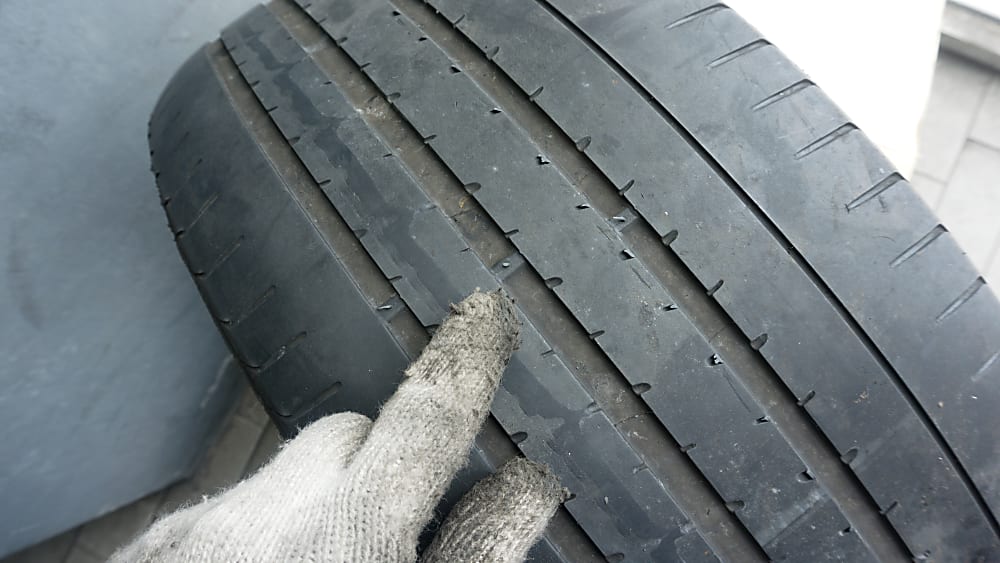 The dimples are superficial.
The dimples are superficial.
Indentations in the tire are best illustrated if you were to imagine tying a string around an inflated balloon and then gently pulling the string tighter. If the balloon is the tire, the string is the embedded carcass cords which are concealed by the rubber. These cords provide the tire with its strength and stability, and transfer steering and braking forces while driving.
During manufacture of a tire – or rather when constructing the carcass, to which the steel belt and the tread are attached – there are often one or two overlaps in the carcass. It's this overlap which is sometimes visible as an indentation after the tire is fitted and inflated.
But if you're in any doubt, have the sidewall indentations checked by a qualified tire specialist.
Cuts are the result of external influences like bad road conditions, protruding bodywork parts, or sharp, foreign objects such as stones or glass. If you discover damage in the form of a cut on the tire surface, you should visit your local tire dealer and have your tires immediately checked by an expert.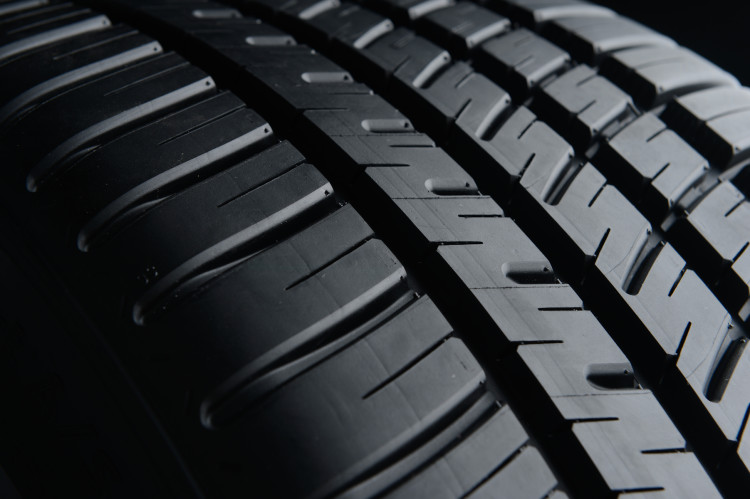
Punctures are the consequence of sharp objects on the road – for example, nails, screws, or broken glass – which pierce through the surface of the tire. If the puncture is deep enough, the tire could begin to lose air pressure. If you find that one or more of your tires are continuously losing pressure, or if you discover a nail or screw embedded in the tread, then visit your local tire specialist as soon as possible to have them repaired.
Change the position of the tires on the car at regular intervals (unless otherwise recommended by the vehicle manufacturer) to promote even tire wear. The position of the tires should be rotated, for example, when making the seasonal transition from summer to winter tires.
By rotating the wheels from the powered to the non-powered axle on a regular basis, drivers can expect to have a uniform pattern of wear on their tires. But as always, please observe the recommendations provided by the vehicle manufacturer.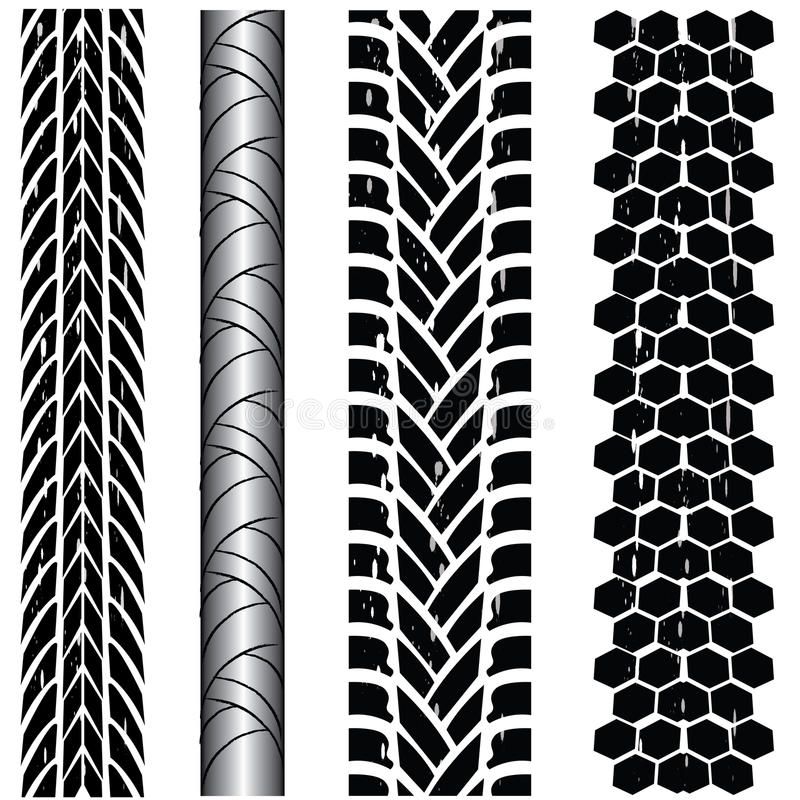
If you find yourself in a situation where you have to drive over an obstacle in the road, approach it slowly and as close to the perpendicular as possible. Afterward, check your tires for exterior damage such as cuts, cracks or bulges. Also, avoid driving aggressively on unpaved roads.
Dealer Locator
Posted by Benjamin Hunting1 Comment on 3 Tire Damage Warning Signs That It’s Time to Replace Your Rubber Know How
Not all tire damage takes the form of punctures that result in easily visible flats. Sometimes, a tire can take abuse that isn’t as simple to spot, due to wear, an impact out on the road or heat.
Regularly inspecting your tires both visually and with a tire gauge — at least once a month — is a great way to make sure that you aren’t at the limits of safety by riding around on rubber that needs to be replaced. Check out these three common types of damage that can signal the end of the line for your tires.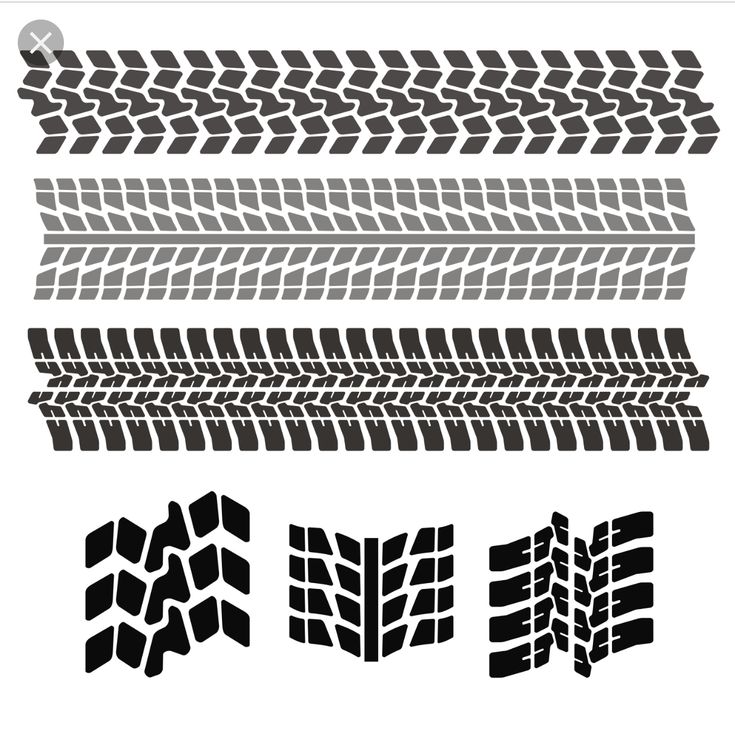
Chunking is the term used to describe missing sections of tread from a tire. It almost looks as though the tread has been sliced or torn off in chunks from seemingly random areas.
Tire damage like this typically occurs for one of two reasons. The first is related to suspension problems, such as a bad shock absorber making it impossible for the tire to maintain constant contact with the road. As it bounces up and down on the pavement, the force of the impact can cause tread chunking. A second common cause of chunking is related to heat — specifically, not warming up a tire before subjecting it to severe stress on an autocross or road course.
Chunked tires are not immediately dangerous, but their lifespan has been significantly shortened. The more tread that’s missing, the less grip they’ll have on the asphalt, which in turn can lead to unpredictable behavior under braking, in inclement weather or when cornering.
2. Bulges, Bubbles and BumpsA bulge, bubble or bump on a tire’s sidewall — even if it’s small — is a more serious cause for concern. This type of tire damage usually results from a sharp impact with a pothole or a curb, which damages its inner liner. As such, air escapes from the liner and begins to push up against the outer rubber of the tire, creating the distended, bulging appearance.
This type of tire damage usually results from a sharp impact with a pothole or a curb, which damages its inner liner. As such, air escapes from the liner and begins to push up against the outer rubber of the tire, creating the distended, bulging appearance.
The important point to remember is that the internal integrity of the tire has been compromised, and it’s no longer strong enough to resist a blow-out should another impact occur. A sidewall bump means it’s time for tire replacement.
3. Tread SeparationThis type of tire damage is often preceded by a vibration from the front of the vehicle that you can feel while driving. It happens when the rubber tread of the tire begins to separate from the casing of the tire itself, which is almost always associated with a manufacturing defect (although abusive driving, serious potholes and significant wear can also contribute).
You may see a warning bubble form in the treaded area of the tire, or you may not. Either way, tread separation is dangerous to the point where the tire must be changed out immediately.
Either way, tread separation is dangerous to the point where the tire must be changed out immediately.
Tires are the only part of your car that touch the road, and their condition is vital to your safety while driving. Stay vigilant for damage, and you’ll roll on for hundreds of thousands of miles without having to worry about the state of your rubber.
Check out all the steering and suspension parts
Photo courtesy of Flickr.
Categories
Know How
Tags
flat tire, know when to replace a tire, replacing a tire, tire blowout, tire care, tire maintenance, tire tread depth gauge, tires, worn out tire
Having been bitten by the car bug at a young age, I spent my formative years surrounded by Studebakers at car shows across Quebec and the northeastern United States. Over ten years of racing, restoring, and obsessing over automobiles lead me to balance science writing and automotive journalism full time. I currently contribute as an editor to several online and print automotive publications, and I also write and consult for the pharmaceutical and medical device industry.
Over ten years of racing, restoring, and obsessing over automobiles lead me to balance science writing and automotive journalism full time. I currently contribute as an editor to several online and print automotive publications, and I also write and consult for the pharmaceutical and medical device industry.
Most often, we ourselves are to blame for the fact that tires become unusable. But this can be avoided.
Related materials
You have never seen such tires: even the police were surprised
In the process of using a tire, a variety of damages can occur, most of which are the fault of the driver. As a result, rubber is wasted, and since the law prohibits the use of different tire models on the same axle, you have to spend money on replacing the second tire.
The most common damage is puncture . This is the most harmless type of damage, but only if you notice it in time and repair it right away.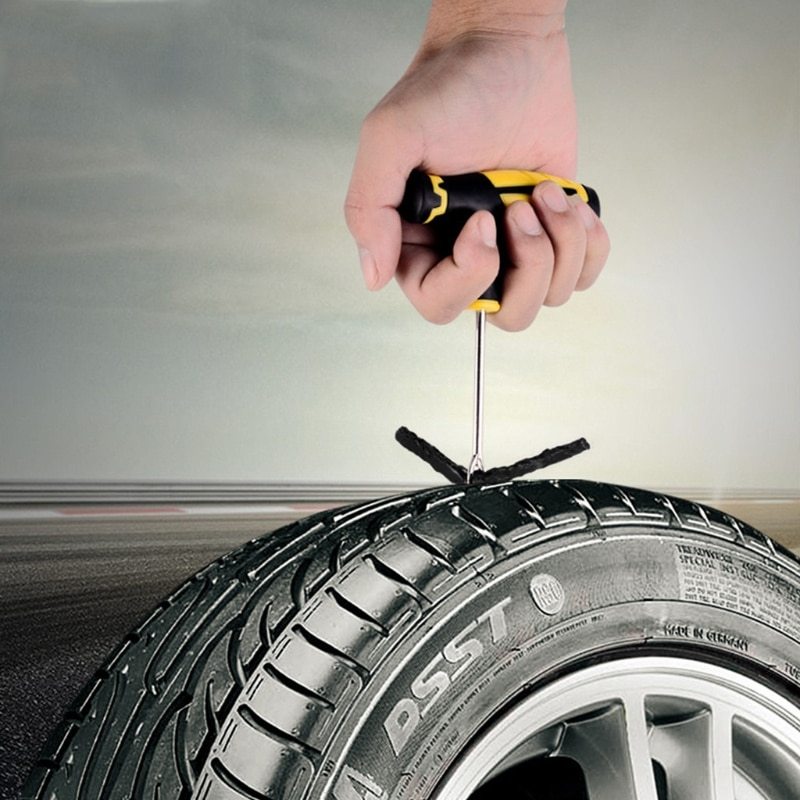 It is absolutely impossible to drive on a flat tire, even a couple of meters! The damage caused by running on a flat tire or with low pressure is catastrophic. This causes the sidewalls to deform more than they should, which causes the tire to overheat, delaminate, and the carcass becomes unusable due to broken cords. As a result, the tire will have to be thrown away. In addition, the edge of the rim can also be damaged.
It is absolutely impossible to drive on a flat tire, even a couple of meters! The damage caused by running on a flat tire or with low pressure is catastrophic. This causes the sidewalls to deform more than they should, which causes the tire to overheat, delaminate, and the carcass becomes unusable due to broken cords. As a result, the tire will have to be thrown away. In addition, the edge of the rim can also be damaged.
Punctures are of two types: with and without cord damage. To determine this, it is necessary to remove what pierced it. If the edges of the puncture tightly converge, then the cord is not damaged and it will be possible to repair the tire without removing it from the disk. Otherwise, if the edges do not converge, you will have to disassemble the wheel and make repairs with strengthening the frame from the inside. Alternatively, in the field and in the absence of a spare wheel, such a puncture can be repaired without removing the tire from the rim, after which you can carefully drive to a tire fitting or garage and make a full repair.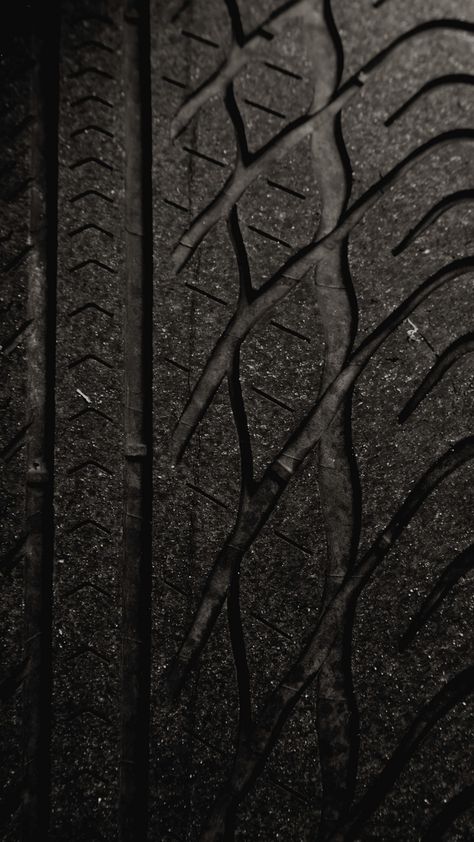
Related materials
Is it possible to pump up a wheel without a compressor - the experiment "Behind the wheel"
When repairing, the puncture site should be cleaned and marked. Further, it all depends on what kind of repair kit you have - as a rule, instructions are attached to them. There are sealants that are poured into the tire through the nipple, after which the wheel turns with the puncture down and the substance seals the hole. Repair using a tourniquet or insert is somewhat more complicated, but also more durable: the edges of the hole are polished with a special tool, after which the tourniquet treated with a special compound must be inserted into the tire through a puncture with a special awl, pulled out (not completely) out and cut flush with the surface.
In case of damage to the cord due to a puncture, the tire must be removed from the rim in order to install a reinforced patch with an additional cord on its inner surface.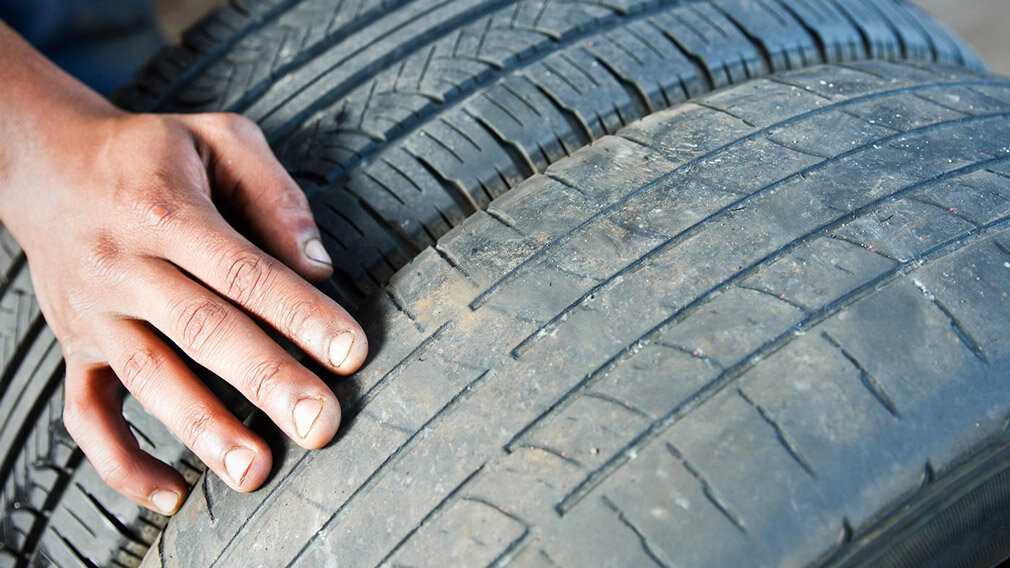 One of the sides of such patches has an adhesive layer that promotes cold vulcanization. After such a repair, wheel balancing will be required. To seal punctures from the inside, patches in the form of a mushroom are also used, with a leg that goes into the puncture. Such patches are also covered with a special adhesive for cold vulcanization.
One of the sides of such patches has an adhesive layer that promotes cold vulcanization. After such a repair, wheel balancing will be required. To seal punctures from the inside, patches in the form of a mushroom are also used, with a leg that goes into the puncture. Such patches are also covered with a special adhesive for cold vulcanization.
Cuts or holes , unlike punctures, are not repairable, as they violate the integrity of the frame, which can no longer be strengthened. In addition, breakdowns are always sudden and occur on the go: the tire abruptly loses pressure and before the car comes to a complete stop it has time to make several revolutions “on the rims”, which breaks the cord and destroys the layers. It is not recommended to use such a weakened tire, even if it was possible to repair and strengthen the place of the rupture or cut, in the future.
Related materials
8 tire storage rules - do you follow them all?
Incorrect storage of tires can cause cracks . The danger of such damage is that moisture enters the cord through cracks, which renders the frame unusable. In addition, air can escape through cracks. Unfortunately, cracks are not repairable, and tires with them will not last long: sooner or later they will deform, become covered with swellings due to rusted and torn cord or because of driving with pressure below the recommended one.
The danger of such damage is that moisture enters the cord through cracks, which renders the frame unusable. In addition, air can escape through cracks. Unfortunately, cracks are not repairable, and tires with them will not last long: sooner or later they will deform, become covered with swellings due to rusted and torn cord or because of driving with pressure below the recommended one.
Blisters or bulges can appear on a tire for a variety of reasons - it always happens due to a broken cord or delamination in the carcass. In the first case, an obstacle was hit and the impact broke the cord or the cord was cut through with a sharp object. In the second case, there is no damage on or near the hernia, which means that it appeared either due to a factory defect, or due to frequent driving with pressure below the recommended one. The danger of hernias is that they can explode at any moment and provoke a skid, which will lead to an accident. If there is nothing to replace a tire with a hernia, then it is better to rearrange it to the rear axle and drive very carefully.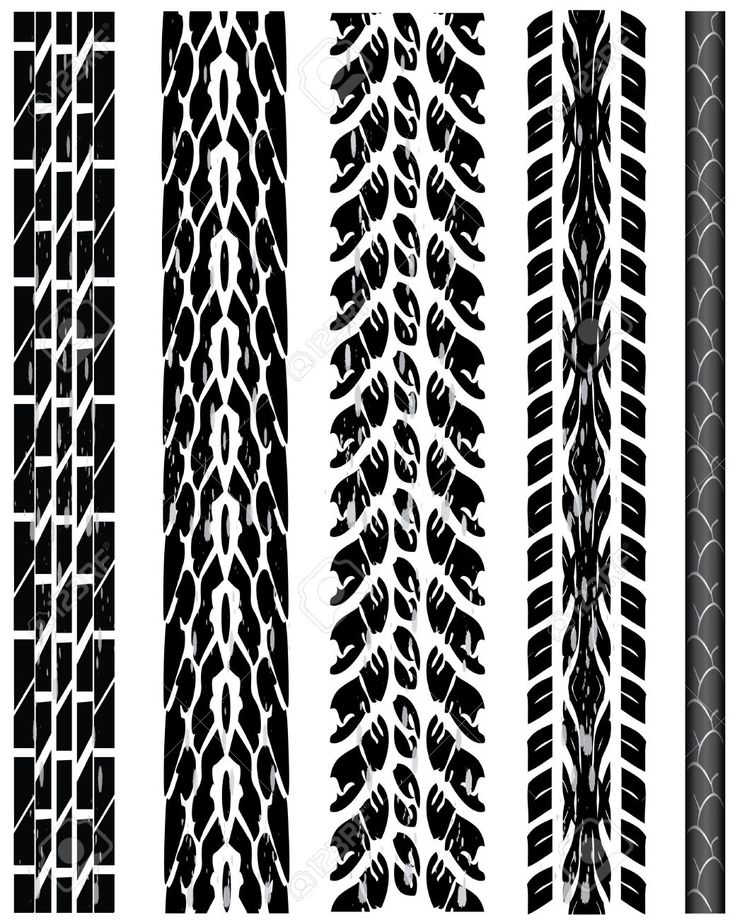 Like cracks, a hernia cannot be repaired. Sometimes small blisters resulting from impacts or cuts are reinforced with reinforced patches, but there is no guarantee that the tire will not explode. Therefore, tires with hernias are recommended to be replaced immediately.
Like cracks, a hernia cannot be repaired. Sometimes small blisters resulting from impacts or cuts are reinforced with reinforced patches, but there is no guarantee that the tire will not explode. Therefore, tires with hernias are recommended to be replaced immediately.
Related materials
Tire blackening - 6 ways to polish. Inexpensive!
Tire sidewalls can be damaged by rubbing against curbstones or the asphalt edge when pulling over. If you are prone to such a driving style, then it is recommended to inspect the inner and outer sidewalls from time to time and, if abrasion is found, swap the wheels in order to prevent the cord from being exposed - the rubber thickness on the sidewalls is small (1.5–3 mm), and it can be rubbed to the frame very quickly.
Often the cause of tire damage can be poor-quality tire fitting , during which the bead ring was damaged. In this case, the tire loses its geometry and “sits” crookedly on the disk - it writes out “eights” during rotation, and lateral vibration appears during the ride.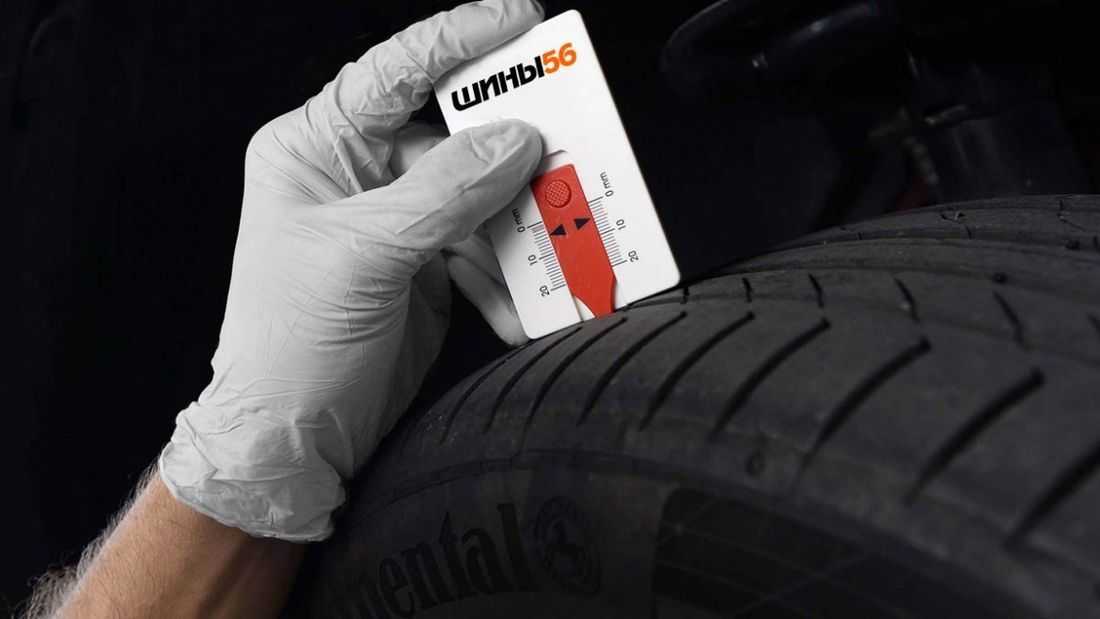 It is impossible to repair such a tire - you need to replace it with a serviceable one as soon as possible before it damages the suspension: rods, hubs and bearings.
It is impossible to repair such a tire - you need to replace it with a serviceable one as soon as possible before it damages the suspension: rods, hubs and bearings.
You can find out whether you are using tires correctly and what invisible damage they have received by the characteristic wear of the tread, the varieties of which are collected in the table for convenience:
Double side shoulder wear
Driving with less than recommended tire pressure.
Inflate the tires to the pressure recommended by the automaker (a plate with recommendations is attached in the driver's door opening) and find the cause of the fall: puncture, cracks, hernia, nipple, rust on the disc rim at the tire fit, etc.
Center wear
Tire pressure too high.
Reduce the pressure to the recommended (indicated on the tablet in the driver's doorway)
In the form of rings and furrows
can be found on trailers or rear wheels of pickups and vans due to vibrations and vibrations and vibrations and vibrations due to vibrations and vibrations bouncing at high speeds.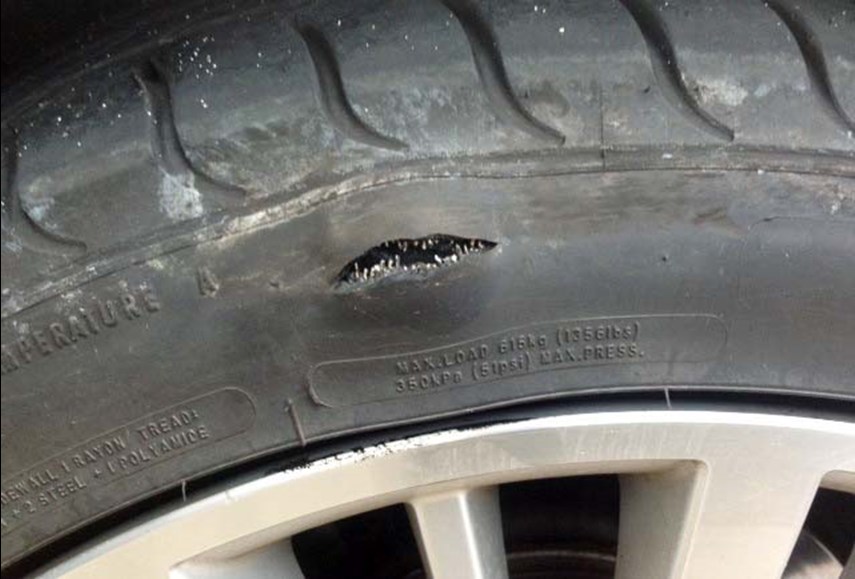
Changing wheels on a loaded axle to equalize wear, driving with a heavier load.
Chipped wear with cuts
Frequent wheel spin on rocky surfaces.
Move the wheels to a non-driving axle, use the gas pedal more carefully when starting to move.
Photo: Petr Urbanek / Unsplash
Our new video
These 5 things you should have in your car in winter. Do you have them?
The most coveted Volga: 7 seats and a TV inside
Kangaroo test: our assembly, Chinese essence, Largus price
Like this note? Subscribe and you will always be in the know!
Driving on Yandex.Zen
News smi2.ru
Introduction
The most common operational tire defects and how to deal with them
Protector distortion
Lump (hernia)
Crack on the side
Uneven wear
Dents on the tread
Cut and puncture
Tread delamination
Spot wear
Diagonal dent
Tread break
Conclusion
Tires, as the busiest and most vulnerable part of a car, are regularly subjected to enormous stress and wear in contact with the track surface.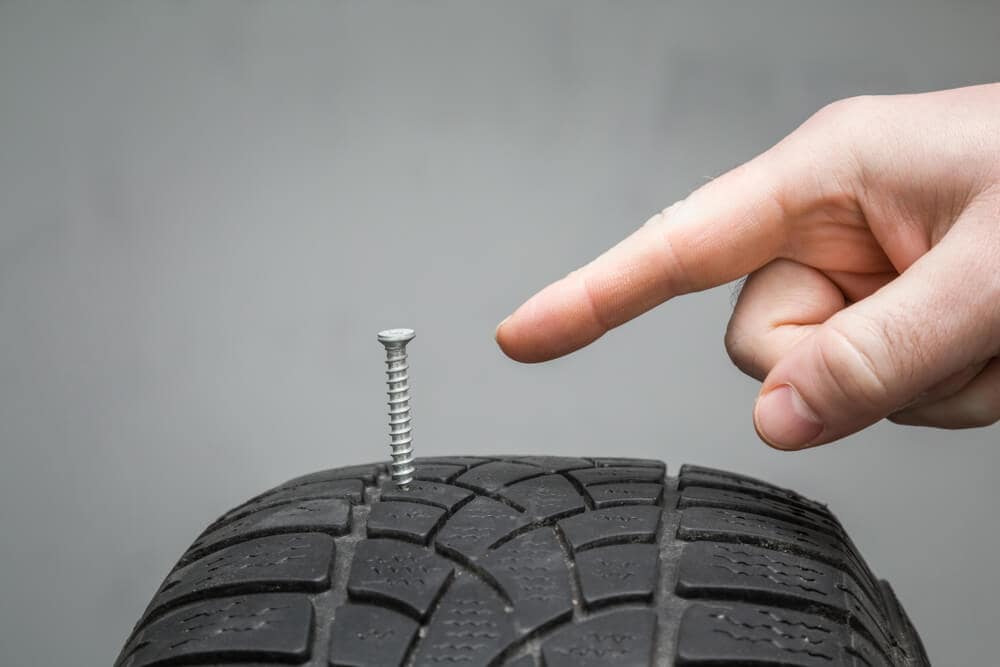 The number of defects and damages, both hidden and obvious, is incalculable. Most of them are caused by improper use of rubber, manufacturing errors or problems with adjacent parts. In the latter case, simply replacing the tires will definitely not solve the problem. We have compiled a short list of "popular" tire problems for cars and provided methods to fix them.
The number of defects and damages, both hidden and obvious, is incalculable. Most of them are caused by improper use of rubber, manufacturing errors or problems with adjacent parts. In the latter case, simply replacing the tires will definitely not solve the problem. We have compiled a short list of "popular" tire problems for cars and provided methods to fix them.
The surface is deformed with varying degrees of localization. Sometimes a defect in the operation of tires goes beyond their metal parts. This is caused by delamination of the inner layer due to either frequent overloads and shock loads, or corrosion of steel components. Moisture gets inside through microcracks, which causes this defect. This is an extremely serious damage, which does not imply either the further use of rubber or its elimination in tire fitting, since the internal parts of the structure are affected. All that remains is to put in a new one, and hand over the damaged one for recycling.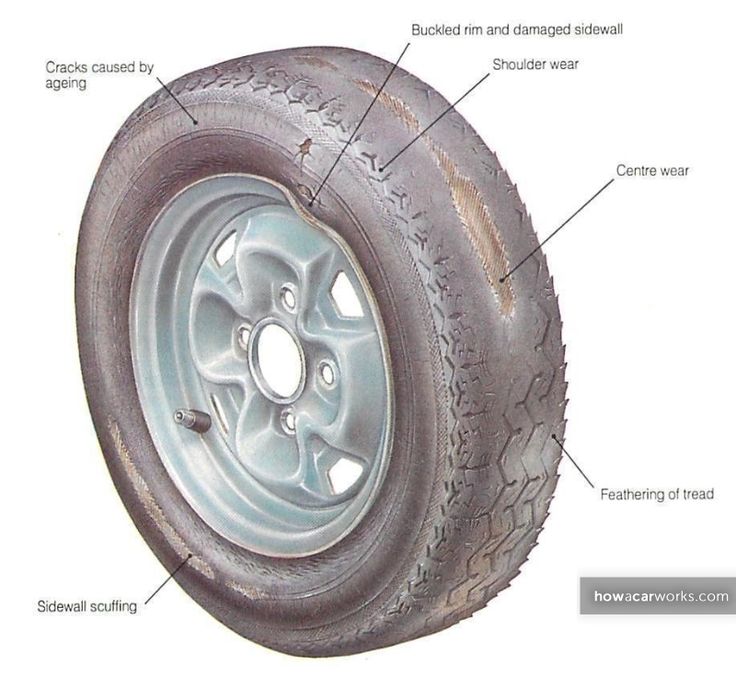
There are only two methods for preventing such damage: monitor pressure, avoid overloading, and regularly inspect tires for such defects. It may happen that such a tire is not the only one, and one of its neighbors has similar troubles in varying degrees of neglect.
A rounded bump may form on the sidewall or on the work surface. The most common cause of a defect in damage to the internal structure of the tire (cord) is the rupture of synthetic threads as a result of overheating at low pressure or due to severe shock loads (unsuccessful hitting a curb, an accident, fast driving over bumps). The problem is exacerbated if the tire is still over-inflated, as some drivers advise, which, they say, improves handling and helps reduce fuel consumption. This is true, but the reverse side of such “savings” is increased wear of rubber, i.e. as a result, the car owner will pay much more by correcting defects.
If the tubercle on the sidewall is practically invisible to the eye (up to 20 mm), then the malfunction can be eliminated in the tire center using a special patch, which will be placed from the back of the tread. Additionally, you can straighten the disc, as it could bend after damage. But if the size of the hernia on the sidewall exceeds 15-20 mm, the tire will have to be replaced immediately, since the defect will only increase with each trip, which will eventually result in severe wear and tear on the go.
Additionally, you can straighten the disc, as it could bend after damage. But if the size of the hernia on the sidewall exceeds 15-20 mm, the tire will have to be replaced immediately, since the defect will only increase with each trip, which will eventually result in severe wear and tear on the go.
A dense network of cracks of various sizes appear on the sidewall of the tires. Such damage usually occurs in old tires, or those that have not been stored properly. High temperatures, humidity, direct sunlight, wear, positioning errors (for example, if they are simply piled on top of each other, which is prohibited for simple rubber without rims) lead to surface destruction and cracking of the sidewalls and the working area. These tires have a gray or greenish tint. If the crack runs along the rim of the wheel, then this directly indicates a lack of pressure.
Repairing an "aged" tire is not very smart, sometimes it's cheaper to buy a new one.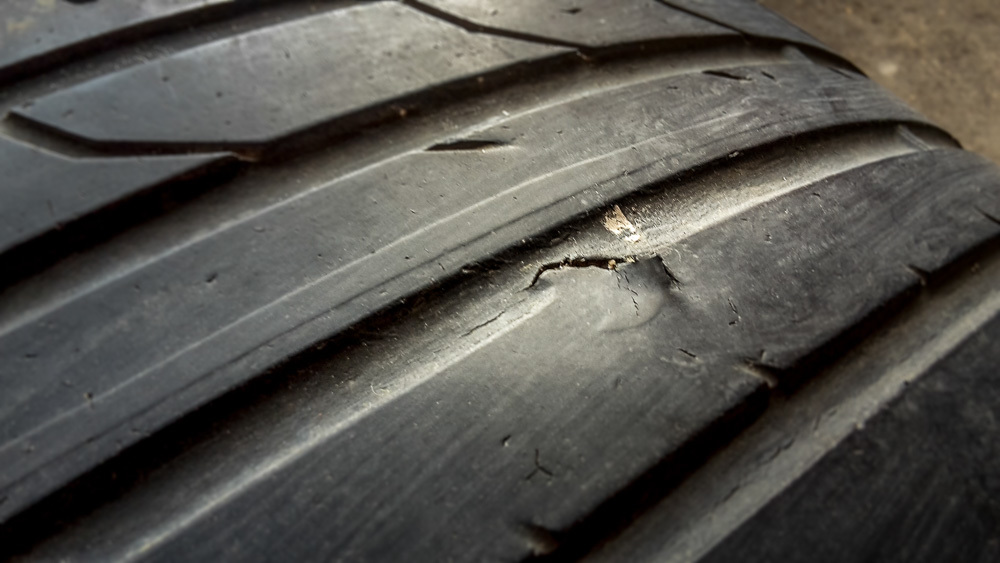 Use or not - you can only judge by the depth of these cracks. If the sidewall damage is not too serious, then the tire can still be used for a couple more seasons, but it is still better to replace it soon, before the cracks get deeper.
Use or not - you can only judge by the depth of these cracks. If the sidewall damage is not too serious, then the tire can still be used for a couple more seasons, but it is still better to replace it soon, before the cracks get deeper.
Running surfaces wear unevenly in certain places, which quickly leads to failure of the entire tire, even if most of the tire does not have serious damage.
Divided into five types of defects:
Wear on one side. Rubber slides off the edge in an even layer without any bumps, abrasions and tears, while the center is relatively intact. Typically, such a defect is formed due to incorrect adjustment of the vertical angle of the wheel - camber, but it can also be caused by other problems with the suspension (wear of springs, hinges, suspension bushings, etc.). You can fix this technical problem only by contacting the tire center, where they will competently adjust the wheel alignment on a professional optical stand. This procedure is quite complicated, it is better not to do it yourself unless you are a technical specialist.
This procedure is quite complicated, it is better not to do it yourself unless you are a technical specialist.
Wear in the middle. Rubber wears out mainly in the central zone, since here the contact with the track is much stronger than on the sides. Because of this, traction is much worse. The main cause of uneven damage is over-inflation of tires, which often occurs if the driver does not control the pressure in cold weather or during sudden changes in temperature. Eliminating the defect is quite simple even with your own hands: you just need to adjust the pressure in all tires.
Side wear. The rubber wears off on the shoulder areas, giving them a more rounded shape. The cause of the defect is low pressure due to frequent trips in an overloaded state or shock loads. You can repair the damage in the same way as in the previous case: add pressure and adjust all wheels to the same level. To prevent this from happening again, you should avoid carrying heavy loads and drive more carefully.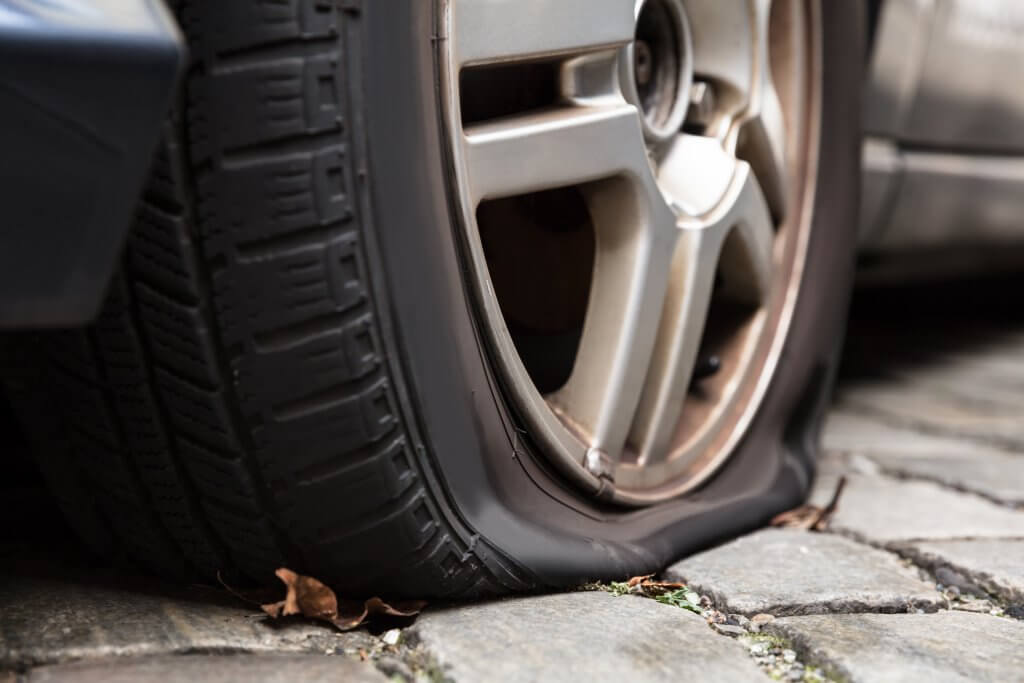
Wavy wear. Damage in different places in the form of a spot or wave. Most often, this defect is typical for the rear axle of the car due to incorrect wheel geometry and suspension problems. Most likely, the alignment is broken, which can only be corrected in the tire center at a special alignment stand.
If the damage is not too severe and the depth of the grooves is more than 4 mm, then the tire can still be used successfully, provided that you have eliminated the cause of uneven wear (set the wheel alignment, eliminated excessive loads, adjusted the pressure, etc.).
On its surface there is a relief from a huge number of bumps and dents. This damage is due to serious problems with the suspension, which cannot cope with shock absorption, and as a result, most of the load falls on the wheels, which provokes additional wear. Even worse if the driver is used to driving over rough terrain.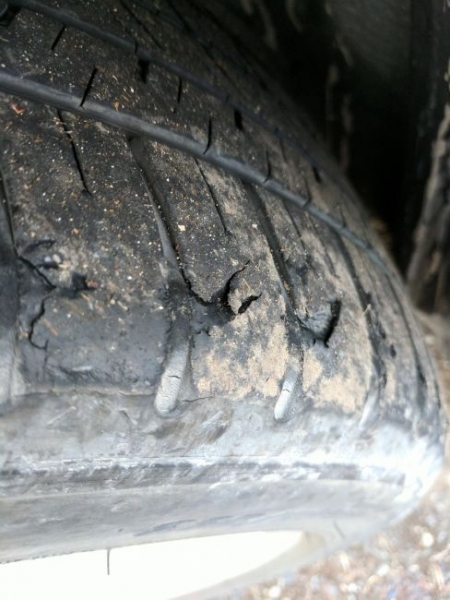 Ultimately, the load is distributed extremely unevenly, which gradually leads to such a defect.
Ultimately, the load is distributed extremely unevenly, which gradually leads to such a defect.
The only way to repair the damage is to go to a car service, where professionals will conduct a complete diagnosis of the suspension and identify the cause of tire wear (camber, shock absorbers, etc.). It is unlikely that they will help you in tire fitting, since it is already impossible to correct the shape of the tire.
Rubber has come apart in the working area or on the sidewall. If we exclude deliberate damage by an ill-wisher, then such damage, as a rule, occurs as a result of a collision with sharp objects (glass, nails, metal parts, etc.) or collisions. You can give the tire for repair, but if the depth of the “wound” of the sidewall reaches the carcass itself, then only a new tire will help.
Part of the tire is torn off due to damage to the internal structure. The reason for this defect is frequent overloads and low tire pressure. As a result, the rubber overheats, the metal insides are oxidized and the components are separated. It will not be possible to fix such technical problems in tire fitting, and the only way out here is a new tire. In the future, you should strictly adhere to the manufacturer's recommendations for the proper operation of rubber, monitor the level of wear.
As a result, the rubber overheats, the metal insides are oxidized and the components are separated. It will not be possible to fix such technical problems in tire fitting, and the only way out here is a new tire. In the future, you should strictly adhere to the manufacturer's recommendations for the proper operation of rubber, monitor the level of wear.
Indentation or damage in one place, usually accompanied by numerous nicks and tears at the edges. The most common cause of a defect is very sharp braking with simultaneous skidding. Vehicles without ABS are particularly susceptible to this type of damage because they do not have anti-skid protection. More dents can appear on cars that have been in one place for a long time. Also, the matter may be in the deplorable state of the brake system, which requires repair of the wheels. In the future, it is not recommended to use a damaged tire, as it will cause strong vibrations and shaking, not to mention increased wear.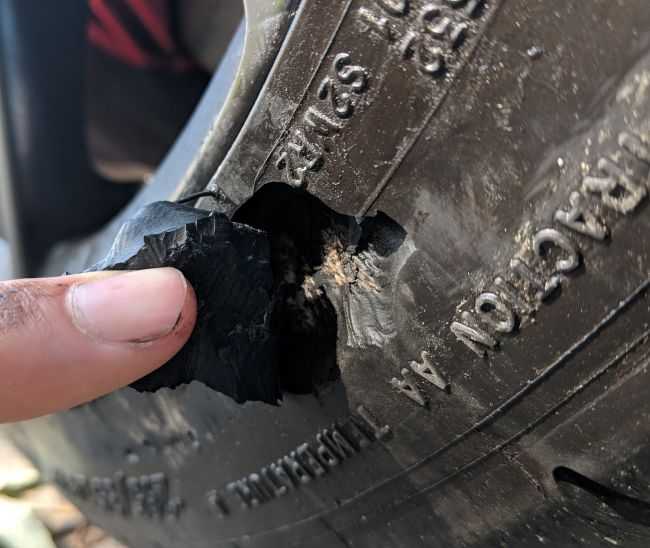
The dent runs along the work area, causing uneven wear. Such a defect is typical for rear axle tires in front-wheel drive vehicles that have incorrectly set camber angles. Or the reason is that the driver overloads the trunk too often, and all the weight is constantly pressing on the rear wheels, causing damage. It's unlikely to fix the dent.
There are tears and cracks on the blocks or on the side. This usually occurs among lovers of drifting and aggressive driving on winding and broken roads. This style of driving significantly reduces the service life, leads to numerous damage to the working area and heavy wear. Rubber will still serve if it does not have deep cracks, however, if you do not change your habits, then in the end the tire will simply explode on the go. In the future, uneven, grainy asphalt pavements should be avoided.
The most common cause of all defects is too much or too little pressure.